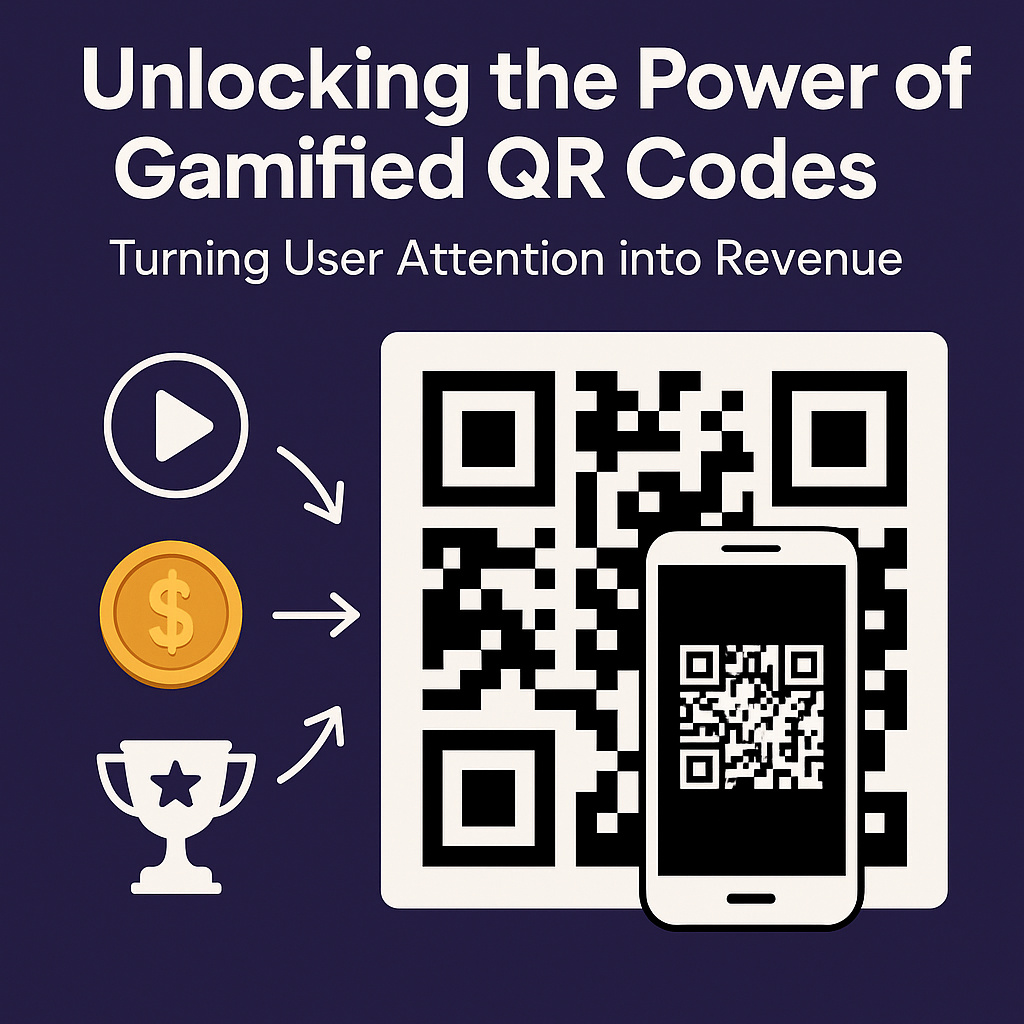From Attention Economy to Gamified Engagement
Consumer attention has become scarce, valuable, and increasingly difficult to capture. The digital landscape has fundamentally transformed into what experts call an “attention recession”—a state where companies compete fiercely for finite consumer focus while facing mounting pressure from economic uncertainty, zero-click search results, ad fatigue, and an endless stream of content.
Yet paradoxically, social media and mobile technology have made purchasing easier than ever. Approximately 76% of users say social media has influenced a purchase in the last six months, proving that connection and engagement still drive commerce.
In this environment, user attention isn’t merely a metric—it’s a form of currency that can be captured, exchanged, and monetized. Gamified QR codes offer a powerful mechanism to do precisely that.
Understanding the Problem: Why Traditional Marketing Is Failing
Traditional advertising models face systematic breakdown across multiple dimensions.
Rising costs make competition unsustainable for most brands. Marketers spent nearly USD 1.1 trillion on global advertising in 2024—a 7.3% increase from 2023. For most businesses, especially small and mid-sized enterprises, competing at these spending levels is economically impossible.
Consumer resistance has reached critical levels. Moreover, 31.5% of internet users employ ad blockers at least sometimes (as of Q1 2024). Beyond blocking, shoppers skip video ads, ignore banners, and mentally filter out marketing messages. Passive display advertising generates minimal engagement because audiences have been trained by decades of marketing to ignore it.
According to Think with Google, brands face an “attention recession” where consumer focus has become harder than ever to capture. The problem is structural: attention is finite, distractions are infinite, and traditional interruption-based marketing no longer works.
The Solution: Gamified QR Codes Transform Value Exchange
Rather than fighting for fleeting attention, gamified QR codes reward genuine engagement. This represents a fundamental philosophical shift: instead of consumers being targets, they become participants.
Here’s how the mechanism works:
A customer scans a QR code displayed on packaging, in-store signage, or promotional materials. Rather than opening a static link, the code triggers an interactive experience—a mini-game, scratch-to-win card, quiz, or augmented reality filter. Upon completion, the user receives immediate, tangible value: a discount, loyalty points, exclusive content, or entry into a prize drawing.
Simultaneously, the business captures valuable first-party data: scan timing, location, device type, completion status, and reward claimed. This creates a win-win exchange where customers feel their attention has genuine worth while businesses gather actionable insights.
Why Gamified QR Codes Work: The Evidence
1. They Leverage Scarce Attention Strategically
Gamification engages consumers at precisely the right moment when they’re already open to interaction. Crucially, the experience rewards that attention rather than stealing it. This fair value exchange fundamentally differs from traditional advertising’s extractive model.
2. Exceptional Engagement Metrics
Intentional scans generate dramatically higher engagement than passive impressions. Industry data consistently shows:
59% of consumers scan QR codes daily QR-linked experiences achieve 3–4× higher engagement than traditional channels Campaigns with QR codes reach approximately 14% scan rates versus 0.01% click-through rates for banner ads 58% of businesses using QR codes report revenue increases 95% use QR to collect first-party data, increasingly crucial in a post-cookie environment
3. Immediate, Tangible Value
Gamified QR initiatives only succeed when users receive something genuinely worth their time. Whether it’s a meaningful discount, loyalty points, exclusive content, or entertaining engagement, the reward must feel proportional to the effort. This perceived fairness fosters habit formation and strengthens brand affinity.
4. Privacy-First Data Collection
Each scan yields first-party data collected directly from willing participants. Furthermore, with AI integration, brands can tailor content, difficulty levels, and rewards based on who is scanning and when, enabling hyper-personalized experiences that feel relevant rather than manipulative.
5. Seamless Offline-to-Online Bridge
QR codes unify physical and digital touchpoints. In-store signage links to tutorials and loyalty benefits. Product packaging connects to sustainability data and product stories. Events combine gamified experiences with brand engagement. This integration creates coherent omnichannel experiences rather than fragmented interactions.
6. Future-Proof Technology Stack
As 5G networks mature and AR/VR technology advances, gamified QR codes become increasingly immersive. The technology foundation that works today scales effortlessly into tomorrow’s more sophisticated experiences without requiring fundamental redesign.
Building an Effective Gamified QR Campaign
Step 1: Define Clear Objectives and Rewards
Clarify your primary outcome: awareness building, lead generation, direct sales, or loyalty strengthening. Subsequently, offer compelling value that matches this objective. Tangible benefits drive engagement; vague incentives generate minimal response.
Step 2: Design Visually Compelling Codes
Generic black-and-white squares disappear in crowded environments. Ensure strong contrast and strategic placement. Importantly, customize with brand colors and logo while maintaining scannability across devices. Add clear calls-to-action: “Scan to play & win” communicates intent instantly.
Step 3: Create Engaging Game Mechanics
Match formats to your audience and context. Scratch-and-win cards work in retail. Quizzes fit product education. Treasure hunts suit events. Spin-to-win mechanics drive engagement. Additionally, blend instant rewards (immediate discounts) with progression mechanics (points, levels, badges) for sustained motivation. Keep interactions short—10 to 30 seconds to payoff—so users see value quickly.
Step 4: Integrate Tracking and Analytics
Monitor every interaction: scans, completions, reward claims. Connect this data to your CRM or customer data platform for sophisticated segmentation. Furthermore, identify top placements by location and time, enabling data-driven optimization over time.
Step 5: Promote Strategically Across Channels
QR codes perform best when discovered through multiple touchpoints. Place codes on packaging, point-of-sale displays, windows, direct mail, and paid media. Additionally, encourage organic sharing by rewarding referrals—users earn bonus points when friends complete campaigns.
Step 6: Prioritize Security and Transparency
Use HTTPS links and communicate clearly how you use customer data. Moreover, implement encryption (AES-256) to demonstrate security commitment. Transparency builds long-term trust that drives repeated engagement.
Real-World Success Stories
Jameson — Brand Loyalty Beyond the Product
Jameson Connects uses QR codes on bottle necks to unlock recipes, merchandise drops, and early event notifications. By inviting customers to look “beyond the bottle,” the brand deepens emotional connection and encourages repeated scanning.
Kellogg’s — Inclusive Design in Action
Kellogg’s partnered with NaviLens to add enhanced QR codes to cereal boxes. These codes scan from up to three meters away, and the companion app reads ingredients and allergy information aloud—a powerful accessibility feature that demonstrates inclusive design thinking.
Sephora — Seamless Omnichannel Integration
Sephora’s QR codes provide instant access to beauty tutorials, product reviews, and virtual try-ons, while linking to loyalty program benefits. This integration bridges offline discovery and digital conversion, creating frictionless customer journeys.
Capitec Bank — Rapid Adoption Through Clear Value
In 2021, Capitec launched Pay Me, a QR-based payment feature. The platform attracted 2.5 million sign-ups in a single week—evidence that clear benefits (instant payments, integrated discounts) accelerate technology adoption dramatically.
BBQGuys — Traditional Channels Renewed
Retailer BBQGuys added QR codes to physical catalogs and witnessed a 1,925% increase in engagement plus a 16% boost in average order value. Even legacy marketing channels gain new life when paired with interactive QR experiences.
The Future: Emerging Technology Integration
Immersive Experiences Through AR/VR
As 5G deployment accelerates and mobile GPU capabilities expand, QR codes will trigger increasingly sophisticated augmented and virtual reality content. Users will preview products in their homes, experience interactive 3D demonstrations, and participate in virtual try-ons with near-instantaneous load times.
AI-Driven Hyper-Personalization
Machine learning will adapt every element of the gamified experience to individual users. Difficulty levels will adjust automatically. Rewards will personalize based on preference history. Narratives will shift based on prior interactions. Each user receives a unique journey tailored to their behavior.
Data Security as Competitive Advantage
With greater data collection comes heightened responsibility. Leading brands will differentiate through transparency, robust encryption, and explicit user consent. Trust becomes the ultimate competitive advantage.
Sustainability Alignment
QR codes will increasingly link physical products to detailed sustainability information. Carbon footprints, sourcing transparency, and recycling options will be readily accessible. Gamified missions can reward eco-conscious choices, aligning corporate sustainability commitments with measurable consumer action.

Ready to Turn Attention Into Measurable Revenue?
VISU helps brands transform every QR scan into gamified engagement, real rewards, and transparent analytics — so you can see, prove, and scale the impact of user attention across channels.
Conclusion: Redefining Value Exchange
In an attention economy where consumer focus is increasingly scarce and valuable, gamified QR codes provide a transparent, measurable mechanism to create fair exchanges:
Customers receive genuine value for their attention rather than surveillance and manipulation.
Businesses unlock new revenue streams and develop measurable customer insights.
Advertisers reach genuinely engaged audiences rather than passive viewers.
This represents a fundamental shift from extractive to reciprocal marketing—where both parties benefit from the interaction. As AR, VR, and AI technologies mature, these experiences will only become more compelling, immersive, and effective.
The brands that begin implementing gamified QR codes now will build customer relationships grounded in mutual respect and genuine value exchange. They’ll have sustainable competitive advantages that outlast any individual campaign.
FAQ: Gamified QR Codes and the Attention Economy
What is the difference between traditional ads and gamified QR campaigns?
Do gamified QR codes only work for large brands?
What kind of rewards perform best in gamified QR experiences?
How can brands measure the ROI of gamified QR codes?
Are gamified QR experiences privacy-safe for users?

